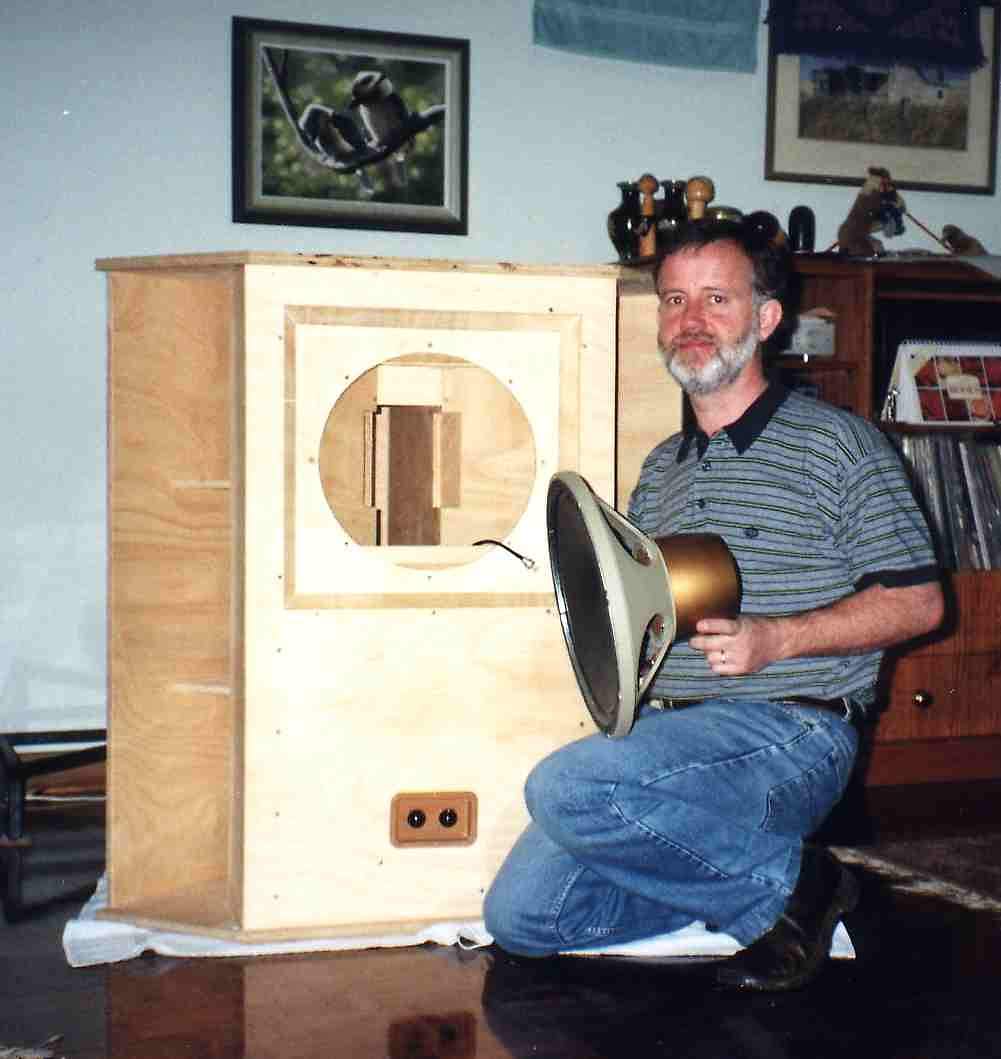

Pictured below are the construction stages of some Tannoy Dual Concentric Monitor Gold loudspeaker horn enclosures; marketed as the "GRF" (Guy R. Fountain) enclosures; built by Richard Norrish in Adelaide, South Australia. This daunting project took many days and nights of brain tearing carpentry, and the results are spectacular, producing a sound of effortless breadth and midrange/ bass detail that conventional direct radiating loudspeakers are unable to reproduce with the same characteristics. The enclosure design was supplied by Tannoy in response to enquiries made by Rick to Tannoy via email.
Having recently heard these enclosures, I have surmised that the main difference between the sound of horns and conventional direct radiator designs is not the amount of bass, or even the frequency response characteristics as a whole, but more the ability to reproduce transients as they occur in real life. The horn enables the speaker to couple to the air with very high efficiency and very high damping. It is the coeffeicient of coupling to the air that is so different from direct radiator speakers, and the reason why inefficient speakers can never deliver realistic transient response. The typical bass reflex design produces large amounts of "fake bass" because the speaker in conjuction with the vent rings and smoothes out transients into lumps or thumps of largely irrelevant low frequency information. This pads out the sound and gives the impression of extended response. Obviously this is an excellent and cheap way of enhancing the performance of small speakers, but is totally off beam for large units. This observation, by the way, is coming from a person who has been a fan of bass reflex designs all his life! A good test for a speaker is to input a square pulse - theoretically the output should be nothing because the pulse consists of DC and infinitely high rise times. With an average speaker the output will be a loud thump because the speaker acts as a low pass filter, and rings excessively. With a good horn design, the output is minimal, due to the very high damping and efficiency. The upshot of all this is the horn design has the ability to seperate bass and midrange information and produce an astounding 3D sound stage. The less "produced" and gimmicky the recording is, the better it sounds. Kick drums "kick" and stop, they don't thump. 10 watts per channel fills the room with concert like volume, and even at very high volumes the cones barely move. Turn up the wick and they just keep getting louder without stress or compression. Having heard these Tannoys in more conventional enclosures I can say that the transformation is total. It also shows that conventional measurements performed on loudspeakers such as swept sine wave response curves are quite meaningless - there are simply too many variables in complex musical waveforms.
Why are there so many people who don't like horn speakers? My guess is, for one thing they are large; incredibly expensive to buy (in Australia the Tannoy
Westminster Royal HE would tally at about $49,000), or so difficult to make, most people may rationalize that they aren't interested.
Tannoy released a reissue of the vintage GRF Memory HE which were similar to the Yorkminster corner enclosures, but these are not the horn designs of which there were two. The ones shown below were the slightly less complicated design.
The builder used Corel Draw to calculate the missing bits of data from the plans, and print life size templates for routing the top and bottom pieces. He constructed a quarter size model from high density cardboard to proof build the design before going ahead with the real thing. The project took aproximately 12 weeks to complete; working nights and weekends.
These enclosures were specified for the 'Monitor Gold' series for achieving the best possible results from these these drivers with the technology of the period. It could be said that the best technology of the period probably surpases many of the so-called 'state of the art computer based design' technologies which exist today in loudspeaker design, and thus opens up a whole debate on the validity of many of the so-called advancements of modern audio. Without being a technological rechabite (we all know how CD has brought immeaserable advantages to our audio lives!), any person who has read on subjects such as quantum physics, would appreciate that there appears to be is no such thing as absolute knowledge, and therefore (it follows) absolute advancement in any field of human endeavour or experience - modern "architecture" is a good example, with the less than outstanding designs failing to justify the destruction of the buildings they were purportedly designed to replace. Ofcourse opinions are like pairs of speakers, everyone has at least at least one or two ...
It's a bit like driving a modern car, and trying to compare the mundane advantages of the technological item to the experience of an older car which was designed with passion and flare, by a person or persons inspired by a more poetic vision of the world around them!
No - you can't have it all!
| Finished Tannoy enclosure with scale model (used to check design dimensions) on top. |
|
| Enclosure before mounting 15" Monitor Gold Tannoy. |
|
|
The builder Richard Norrish with Tannoy Monitor Gold |
 |
| To page 2. |
| To Crossover mods page |
| To original Tannoy brochure. |
| Back to HOME PAGE |